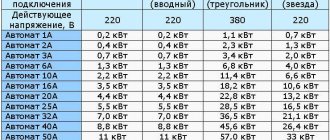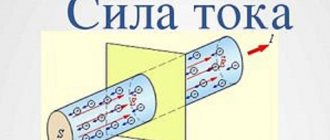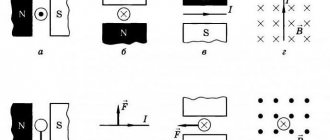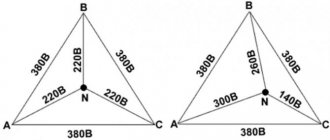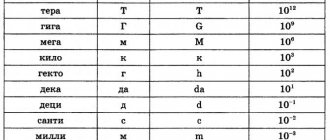Amperes and kilowatts are characteristics of the electricity consumed by devices connected to the network. The first is also called load, and the second is called power. The need for translation arises at the stage of selecting protective devices, the markings of which most often indicate only the current strength.
You will learn everything about how to convert Amperes to Kilowatts from our proposed article. We will look at the theory, understand the basic principles of translation, and then explain the meaning of these actions using practical examples. By following our advice, you can perform such calculations yourself.
What is the difference between ampere and kilowatt
The fundamental difference between the units of measurement of electrical network parameters, which are included in the title of this section, is that they represent a numerical measure of various physical quantities.
In this case:
- amperes (abbreviation A) show current strength;
- watts and kilowatts (abbreviation W and kW, respectively) characterize active (actually useful) power.
In practice, an expanded description of power is also used, measuring it in volt-amperes and, accordingly, kilovolt-amperes, which are briefly referred to as VA and kVA.
They, unlike W and kW, which describe active power, indicate total power.
In DC circuits, the apparent and active powers are the same. Similarly, in an AC network, with a small load power, at the engineering level of rigor, the difference between W (kW) and VA (kVA) can be ignored, i.e. work only with the first two units.
For such circuits the following simple relation applies:
W = U*I, (1)
where W is the (active) power specified in W, U is the voltage specified in volts, I is the current measured in amperes.
When the load power increases to a level of a thousand watts and above for direct current, relation (1) does not change, but for alternating current it is advisable to write it as:
W = U*I*cosφ, (2)
where cosφ is the so-called power factor or simply “cosine phi”, showing the efficiency of converting electric current into active power.
In physical meaning, φ represents the angle between the vectors of alternating current and voltage or the phase shift angle between voltage and current.
A good criterion for the need to take this feature into account are those cases when VA or kVA are indicated instead of kW in the nameplate data and/or on the body nameplates of electrical appliances, mainly powerful ones with a consumption of more than 1 kW.
Typically, for household electrical devices with powerful electric motors (washing machines, dishwashers, pumps and the like) you can set cosφ = 0.85.
This means that 85% of the energy consumed is useful, and 15% forms the so-called reactive power, which continuously transfers from the network to the load and back again until it is dissipated in the form of heat during these transitions.
At the same time, the network itself must be designed specifically for full power, and not for useful power. To indicate this fact, it is indicated not in watts, but in volt-amperes.
As a unit of measurement, the watt (volt-ampere) is sometimes too small, resulting in numbers that are difficult to visually perceive with many digits. Taking this feature into account, in some cases power is indicated in kilowatts and kilovolt-amperes.
For these units the following is true:
1000 W = 1 kW and 1000 VA = 1 kVA. (3).
FAQ
How many Watts are in Ampere?
If we are talking about a car network, then in one ampere there are 12 watts at a voltage of 12V
.
In a household electrical network of 220 Volts
, a current of 1 ampere will be equal to the consumer power of
220 Watts
, but if we are talking about an industrial network of
380 Volts
, then
657 Watts per ampere
.12 amps how many watts?
How many watts of power at 12 amperes of current consumption will depend on the network voltage with which the consumer himself operates. So 12A it could be: 144 Watts in a 12V car network; 2640 Watts in a 220V network; 7889 Watts on a 380 Volt power supply.
220 watts how many amps?
The current strength of a 220 Watt consumer will differ depending on the network in which it operates. This can be: 18A at a voltage of 12 Volts, 1A if the voltage is 220 Volts, or 6A when current consumption occurs in a 380 Volt network.
Why is there a need to move from amperes to kilowatts and back?
It is impossible to reduce the description of an electrical network to just one unit. The need to use two different units of measurement of parameters arises due to the fact that in the vast majority of cases, a particular wiring serves several consumers, each of which contributes to the strength of the flowing current.
As a result
- It is convenient to calculate the cross-section of the wires based on the maximum strength of the current flowing through them;
- circuit breakers that protect receivers and wires from overload and short circuit are selected in the same way;
- The main characteristic of any electrical device connected to a socket as a current collector or load is traditionally its power.
The popularity of indicating power consumption, as one of the main parameters of an electrical appliance, is also determined by the fact that payment for electricity is carried out using an electric meter, which is calibrated in kWh.
Accordingly, given the known cost of one kW*hour, payment for electricity is determined by simply multiplying three numbers: power, operating time and cost of one kW*hour.
Taking into account the peculiarities of determining electricity costs, it becomes clear the advantage of using for powerful devices not useful power, measured in kW, but total power, which is determined in kVA.
It is advantageous in that it makes it possible to perform calculations using a single method without separately taking into account the actual phase shift of current and voltage.
The principle of identical calculations when knowing the total power also applies to current calculations.
The conversion from one unit to another is carried out according to the relations (1) and (2) presented above and, due to their simplicity, does not pose any big problems.
In this case, the fact that voltage U can be considered a constant, which varies only depending on the number of wiring phases, plays a role.
Below we present the basic rules for performing such calculations in relation to the most common cases in practice.
Necessary calculations
First you need to check the sockets that are connected to the selected machine. Sometimes an automatic device powers not only household appliances, but also lighting devices. If the electrical wiring in the house is not installed correctly, the entire supply may depend on only one device. They count the total number of consumers and add up the voltage they need to operate.
The result will be the sum of watts that the automatic device supplies to these devices. Most likely, the equipment will not be connected at the same time, but the formula will make it possible to calculate the maximum voltage consumption. If some device does not indicate a specific power, but its interval, then it is necessary to take the largest value.
Minimum values are not taken into account, since in this case the machine will operate at full load. This is unacceptable, because there are interruptions in the network, and this will lead to breakdown of the disconnecting device. The voltage in private homes and in industrial enterprises is different. There are two types:
- single-phase network - 220 V;
- two-phase - 380 volts.
Determination of power by current strength for a single-phase network
The need to perform this procedure most often arises when setting restrictions on the maximum power of an electrical appliance that can be connected to a specific outlet or group of outlets.
If this restriction is violated, the risk of fire increases, and the plastic decorative elements of the outlet may melt due to excess heat generated.
Based on the definitions, which are described in mathematical form by expressions (1) and (2), to find the power, you simply multiply the current by the voltage.
The maximum permissible current is indicated on the outlet marking and for most indoor household products of this type is usually 6 A.
The voltage supplied from the mains to the outlet is 220 - 230 V. Thus, the maximum power is 1.3 kW.
Separately, we point out that the risks of damage to the outlet when connecting an overly powerful device are minimal in properly designed household wiring.
This useful property is provided by:
- installation of automatic machines;
- the use of plugs in powerful electrical appliances that physically cannot be connected to conventional sockets (mechanical interlocking).
A rather popular direct connection of a powerful stationary device (air conditioner, boiler) to the network without the use of sockets can be considered a unique version of mechanical interlocking.
Is there a difference between Volts and Watts?
First, let's remember what these concepts mean.
Let’s also try to find out if there is a significant difference between them. So, an electrical voltage that produces a current whose strength is equal to 1 Ampere is called a Volt. In this case, it stands in a conductor with a resistance of 1 ohm.
Volts can be divided:
- 1,000,000 microvolts
- 1,000 millivolts
At the same time, we can say that Watt is the constant power of electric current. At a voltage of 1 Volt, its power is 1 Ampere.
Based on the above, we can safely say that there is still a difference between these concepts. Therefore, it must be taken into account when working with various electrical systems.
Conversion of power to current for a single-phase network
Current calculation is usually performed in the process of selecting a machine that serves a powerful consumer such as a direct-flow water heater.
Based on expressions (1) and (2), the problem is solved in one action. To do this, simply divide the power by the voltage.
The power value is given in the technical description of the device or indicated directly on its body. The voltage is assumed to be 220 V, which creates some calculation margin.
For example, with a power of 3000 W, in accordance with the above rule, we obtain a current of 3000/220 = 13.7 A, which indicates the need to use a 16-amp circuit breaker.
When specifying power in kilowatts, one step is added to the calculation: you must first convert kilowatts to watts, taking into account formula (3).
For example, the heater has a power of 2.8 kW. Then the current calculation is performed as follows:
- W = 2.8*1000 = 2800 W;
- I = W/220 = 12.7 A.
If the power is indicated in VA or kVA, then the calculation does not change, i.e. 3000/220 = 13.7 A (in the second case, we first convert kVA to simple VA, i.e. 3 kVA = 3*1000 = 3000 VA).
The main feature in this case is that, taking into account the typical cosφ = 0.85 for household devices, useful work will be performed by 11.6 A (i.e. 85% of the total current), while the remaining 2.1 A is reactive current, which is uselessly spent on heating the wires.
Conversion table
At the moment, you can convert values in forward and reverse order without any problems thanks to a special table called “100 amperes how many kilowatts”. Using it you can easily calculate the required values. It is especially convenient to use when you need to count large numbers. Interestingly, today there are tables designed to calculate the amperage and energy of a single-phase and three-phase circuit breaker. Standard data for those devices that can be purchased on the market today are provided.
To find out the necessary data, you need to use the above formulas or use a translation table. These measurement values will help you calculate the energy used by a specific device and make other calculations in the electrical field.
Subject: Thank you for your answer and I would like to ask you more. The welding machine indicates 160 Amps, how much will it be if converted to kW? And what is 1 ampere equal to in relation to kilowatts? That is, 1A = . kW?
Thank you for your answer and I would like to ask you more. The welding machine indicates 160 Amps, how much will it be if converted to kW? And what is 1 ampere equal to in relation to kilowatts? That is, 1A = . kW?
Consultant Moderators
Re: Thank you for your answer and I would like to ask you more. The welding machine indicates 160 Amps, how much will it be if converted to kW? And what is 1 ampere equal to in relation to kilowatts? That is, 1A = . kW?
Hello. The current of 160A, which is indicated on the welding machine, is indicated for the output voltage (24-48V). Input voltage
220V 50Hz and to protect the circuit from short-circuit currents. a 16-25A circuit breaker can be used. Based on this, you can calculate the real power consumption using the formula P=UIcosφ (where U is voltage (V), I is current (A), cosφ is selected from 0.7 to 1.)
By leaving feedback about the work of a technician on social networks, you help make our work even better.
| Messages 2 |
Quick assessment of currents and powers
The extreme simplicity of the initial relations (1) and (2) makes it possible to significantly simplify the execution of current calculations with the additional condition of specifying the power in kilowatts.
The basis for simplifying the calculations is the fact that, taking into account the approximate constancy of voltage in a household single-phase 220-volt network, the conversion of power into current can be performed by multiplying the power by a constant factor.
To determine such a coefficient, it is advisable to use the fact that when setting W in kW, we have a fairly accurate estimate I = W*1000/220 = 4.5*W.
For example, with W = 2.8 kW we get 4.5 * 2.8 = 12.6 A, i.e. calculations are performed faster and much more conveniently compared to “correct” calculations with a slight loss of accuracy.
Similarly, it is equally easy to show that W = 0.22*I kW. It must be remembered that current I is indicated in amperes.
Thus, we get simple rules:
- one kW corresponds to 4.5 A current;
- one ampere corresponds to a power of 0.22 kW.
The latter rule is often rounded down to one ampere equivalent to 0.2 kW.
Formula for direct current
To determine power at constant voltage, the following expression is used - P=U•I, where:
- P (W) – power of the electrical appliance;
- U (B) – network voltage;
- I (A) – current consumption.
Using the rules of mathematics known from elementary school, you can perform a conversion to determine voltage and current. These formulas have the following form, allowing you to calculate one unknown parameter with the other two known:
- current – I=P/U;
- power – Р=U•I;
- voltage – U=P/I.
In this form they are used primarily in DC networks. At home, this voltage is used in car wiring, as well as when connecting LED strips and modules.
For single-phase and three-phase networks, a more complex formula is needed. It is necessary to take into account additional parameters.
Relationship between power and current in a three-phase network
The principle of calculating power and current for three-phase networks remains the same. The main difference is a slight modernization of the calculation formulas, which allows us to fully take into account the design features of this type of wiring.
The following expression is traditionally taken as a basic relationship:
W =1.73* U*I, (4)
and U in this case represents the linear voltage, i.e. is U = 380 V.
From expression (4) follows the advantage of using three-phase networks in justified cases: with such a wiring diagram, the current load on individual wires drops to the root of three times with a simultaneous threefold increase in the power supplied to the load.
To prove the last fact, it is enough to note that 380/220 = 1.73, and taking into account the first numerical coefficient we get 1.73 * 1.73 = 3.
The above rules for the connection of currents and power for a three-phase network are formulated in the following form:
- one kW corresponds to 1.5 A of current consumption;
- one ampere corresponds to a power of 0.66 kW.
Let us point out that everything that has been said is true in relation to the case of connecting the load with a so-called star, which is most often encountered in practice.
A triangle connection is also possible, which changes the calculation rules, but it is quite rare and in this situation it is advisable to contact a specialist.
How many watts are in 1 ampere?
Now let's try to convert Watts to Amps. And for this we need one more formula:
I=P/U
In it, I is A, P is Watt, and U is Volt.
By making a simple calculation using this formula, we can find out how many Watts are in one A.
As we said earlier, there is another way to calculate how many watts are in 1 A. In order to use it, you will need to open an online calculator and enter the power consumption and voltage into it.
Next, you just need to click on the button labeled “calculate” and within a couple of seconds a special program will give you the correct value. By using this method, you will undoubtedly be able to save your time and effort, since you do not have to independently calculate all the indicators using formulas.
Voltage 380 volts
Calculations for a three-phase network are carried out using a different formula. The voltage in such rooms is 380 V, it is distributed over three wires. Therefore, it is possible to install an automatic shutdown device with a lower rating at the same power consumption. The formula looks like this: P = U x I x root of 3. This way you can find out how many watts are in 1 ampere. To determine the number of kW, you need W x (0.7 x 380).
You can better understand the peculiarities of the calculations using an example. The three-phase network voltage is 380 V, and power supply devices require 0.13 kW of power. You need to find out which machine is best to buy for such a room. To do this, use the formula: 130/380 = 0.5 amperes.
In a similar way, calculations can be carried out for a two-phase network. Its voltage is 266 V. One kilowatt will contain 3.7 A (1000/266). Accordingly, one ampere is equal to 266 watts. For a room with a two-phase network and a power consumption of 250 watts, a machine with a rating of 3.7 amperes is suitable. When choosing a device, you need to take into account the current strength, which is less in a three-phase network for the same amount of power consumption.

